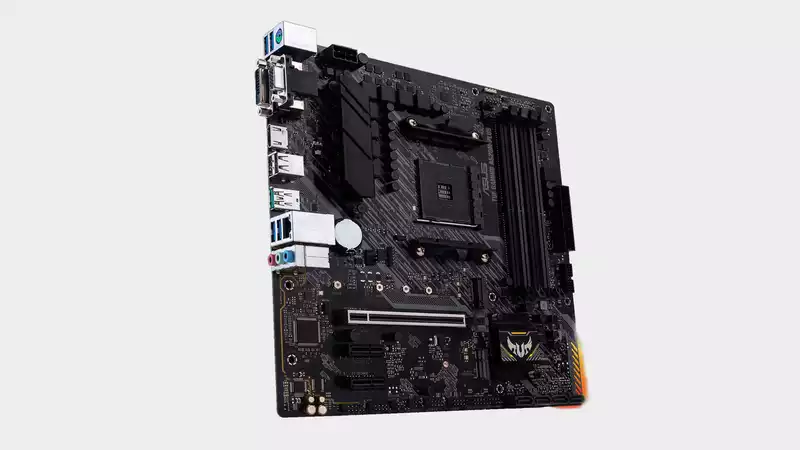The A520 motherboard chipset represents the budget end of the market, ideal for building a budget AMD Ryzen 5000 gaming PC. following the Gigabyte A520 Aorus Elite and ASRock A520M ITX/ac, Asus TUF Gaming A520M Plus is now available; the TUF sub-brand, which originated with Sabertooth motherboards, has expanded beyond Asus to other product lines. Several partners offer TUF products, including cases, memory, and peripherals.
The TUF brand has a reliability and military theme; Asus claims that TUF products are designed for stability and compatibility with other TUF components. While this is mostly a marketing exercise, the yellow highlights and discrete design are an interesting change from the excessive RGB LEDs and snarling beast decor, and the unique aesthetic will appeal to many.
Many gamers want something simple, reliable, and unobtrusive, and TUF products have gained a following among users and gamers who are not interested in ultra-expensive high-end motherboards. Asus buyers tend to be quite loyal, and more TUF products than ever suggests that this brand is here to stay.
As mentioned in other A520 reviews, this budget AMD Ryzen chipset is not for everyone; it does not support PCIe 4.0 and cannot be overclocked, but the truth is that buyers of budget systems will not be overly concerned about these things They will build the system, install the windows, and then install the system. They want to put together a system, install Windows, and immerse themselves in gaming.
If you are on a tight budget, it is easy to allocate a few dollars or pounds to a better graphics card or a better CPU. These are the things that actually make a tangible performance difference.
The A520 chipset also offers some important advantages over Intel's comparably cheap chipset, the B460. The biggest advantage is support for speeds that exceed the memory limitations of Intel's B460. That is, it stops hard at DDR4-2666 or 2933 on i9 CPUs. The Asus TUF A520M, on the other hand, supports memory speeds up to DDR4-4800. Of course, such a combination is unlikely to be possible.
Another big selling point for the A520 (unconfirmed on this board at the time of this writing) is support for the upcoming Ryzen 5000 series CPUs; if AMD's 5000 series CPUs are as fast as AMD claims, then a sub-$100 A 65W Ryzen 5 5600X CPU seems like a good option, but realistically, the A520 will be seen as a more appropriate combination for future Ryzen 3 CPUs and Zen 3 APUs.
But let's look at the Asus TUF Gaming A520M Plus. This is quite a mouthful, so let's hold out for the Asus TUF A520M, which is quite expensive for an A520 board at $148. It is a micro ATX board and appears to be an 8 phase VRM. The heatsink is very small, and while we did not encounter any temperature issues during testing, this is not a setup that will run a 12- or 16-core CPU under load for long periods of time. [There are four RAM slots, one PCIe 3.0 x4 M.2 slot (no heatsink), and four SATA ports. There is also one RGB header and an RGB light in the lower right corner of the board. Interestingly, Asus uses a Realtek L8200A LAN controller, which seems to be exclusive to Asus for now.
The TUF A520M has one USB 3.2 Gen 2 port. This is nice since most A520 boards only have a Gen 1 port. There is also an e-Key 2242 M.2 slot for adding a WiFi card. Does it make sense to have this on a budget board when non-enthusiast users usually just add a USB dongle? Maybe, maybe not.
Rear I/O includes the aforementioned L8200A LAN and USB 3.2 Gen 2 ports, plus four Gen 1 ports and a pair of USB 2.0 ports. In total, there are seven; HDMI 2. One port means that 4K/60Hz is possible with Renoir's APU; there are still plenty of users who use 1080p 60Hz displays, so they don't mind having DVI-D on their budget boards. Nobody uses it anymore; ALC887 audio is common. But at least Asus is making some effort with PCB shielding and decent capacitors.
The AM4 socket is now fully mature and we can't expect the odd fluctuations in benchmark performance that we saw with the first generation of platform releases; the TUF A520 often lags just a bit behind other test boards.
Evaluating cheap motherboards and comparing them to each other can be challenging. Often, one or two features, or even a $10 price difference, can make the difference between the bright and dark sides.One area where Asus tends to gain traction with customers is brand loyalty, and the TUF brand is a way to further this by emphasizing stability and reliability. [However, the Asus TUF Gaming A520M, at its price, is not enough to win an all-out recommendation. It's not bad by any means, but other boards in this price range have things like WiFi and DisplayPort. These things could be the difference between success and failure for your particular build.
The Asus TUF A520M is a generally unremarkable motherboard. It has a decent VRM, the USB 3.2 Gen 2 port is a nice addition, and the e-Key M.2 slot adds a little flexibility. The motherboard is of good quality, but I don't know if it will last long enough to be reliable. We see no reason not to.
Other than the USB 3.2 Gen 2 ports, the board doesn't stand out enough compared to similarly priced MSI Vector WiFi and others. However, the pricing is erratic. If it were $10 cheaper, the whole equation would change; Asus fans and those invested in the TUF ecosystem would be happy with the purchase, but at this price, there are better A520 options.
.

Comments